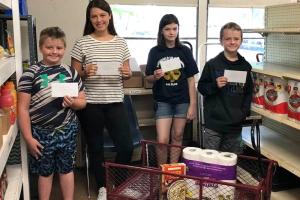Building generosity in young people though community service has always been a pillar of 4-H youth development. University of Illinois Extension staff led the way to take community service to the next level. Throughout 2019, 4-H clubs in Fulton, Mason, Peoria, and Tazewell counties combined traditional community service with experiential learning for a new focus on “service learning.” Club members and leaders worked together to plan, organize, and execute what was referred to as the 4-H 10 Gallon Challenge, in which milk or milk vouchers were donated to local food pantries. The project provided invaluable learning experiences for the members and nutritious dairy products to over 200 families.
According to the USDA National Extension 4-H organization, service learning is defined as a form of experiential learning that combines subject matter learning and critical thinking skill development while addressing a genuine community need. Youth are involved in every step of the process: inquiry, selection, planning, execution, and reflection. Through service learning, youth learn more, become more confident about what they have learned, improve in problem-solving ability, build leadership and social abilities, take more enjoyment in the overall learning experience, retain the subject matter longer, and are more likely to volunteer to serve the community in the future.
To facilitate this shift, the four-county unit came together to plan and implement one large, impactful project. Nearly 50 youth and adult volunteers attended trainings led by Emily Schoenfelder, Extension 4-H educator, to better understand how inquiry, planning, action, and reflection all work together in the service learning process. From here, these newly trained service learning leaders were tasked with helping their clubs explore local needs and submit proposals for projects that could address these issues.
Kassie Haage and the Neighbor Kids Dairy 4-H Club wrote the proposal for the 4-H 10 Gallon Challenge, which was ultimately selected for the unit-wide project. The needs described by this proposal were complex. In the proposal, Kassie explained, “Most, if not all food pantries do not have dairy products available for low income families that visit their facility. There are so many health benefits to adding dairy in the diet that this is a sad situation.” She continued by saying, “Dairy farmers across the country are losing their farms every day...If we do not help dairy farmers increase their income as well as spread this awareness, farms will close.” However, the proposed solution was simple: donate 10 gallons of milk (or other dairy products) to a local food pantry. This would help low income families, local businesses, and farmers.
To help implement this project, a cross-county committee was formed in which youth and adult volunteers assumed responsibility to lead and guide this project. Committee members took on communication with local food banks, coordination of 4-H clubs, marketing the challenge through print and video and researching extra learning opportunities such as guest speakers and field trips.
4-H youth were able to experience the benefits of service learning first hand. In doing so, they contributed to a dozen local food pantries, provided healthy food options to over 200 local families, and gained invaluable life skills!
Service learning projects like this are just one of the many learning opportunities in the 4-H program. Contact your local U of I Extension office and speak to the 4-H program coordinator to learn more about the upcoming 4-H events and clubs in which youth can get involved. Visit the website for more information https://extension.illinois.edu/fmpt
